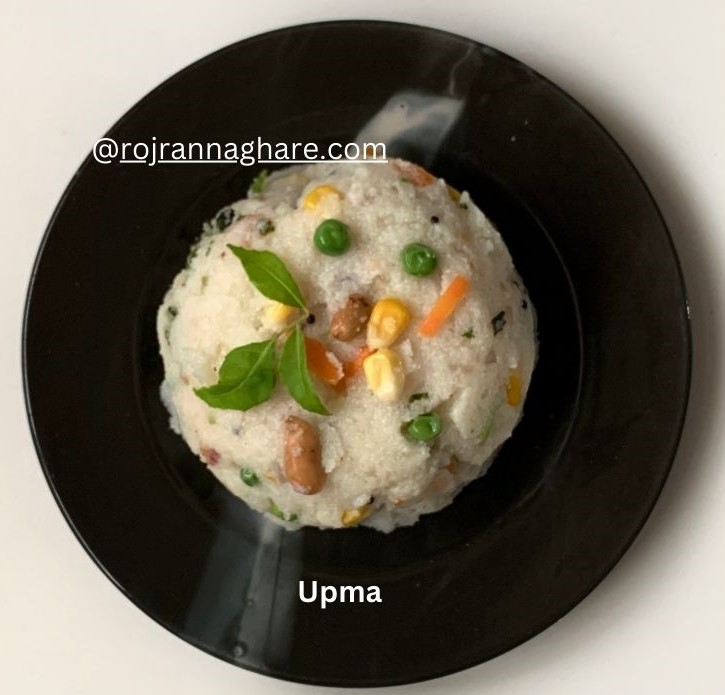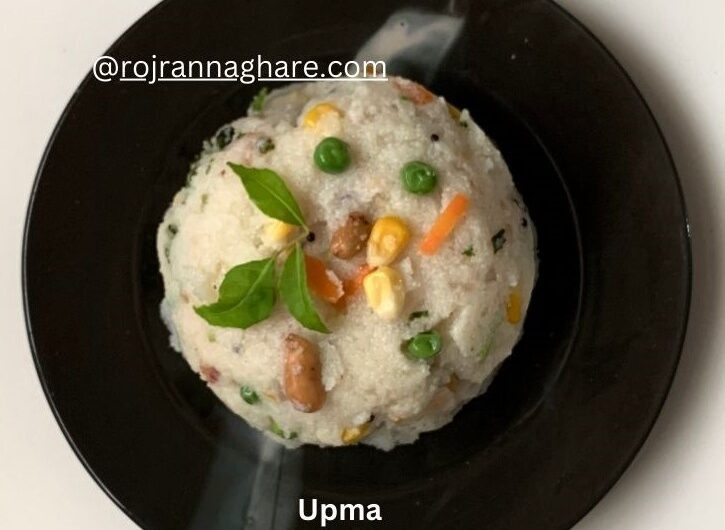Our Healthy Breakfast Upma is a perfect choice for a wholesome and satisfying breakfast option. Packed with fibre-rich vegetables and semolina, this dish not only tastes great but also fuels your day with essential nutrients. Follow our step-by-step recipe to kickstart your morning with a nutritious and delicious meal.
Table of Contents
ToggleWhat is Upma?
Upma is a popular South Indian breakfast dish made from semolina (also known as sooji or rava) or other grains like rice or wheat. It is a versatile dish that can be customized with various vegetables, spices, and seasonings to suit different tastes. Upma has a slightly grainy or porridge-like texture and is known for its savoury and aromatic flavours.
Nutritional Value of Upma:
Upma is a nutritious breakfast option that provides essential nutrients:
Carbohydrates: It is a good source of complex carbohydrates from semolina or other grains, providing sustained energy throughout the morning.
Proteins: Upma contains proteins from the grains and, if vegetables are added, additional plant-based proteins.
Fibre: The dish is typically rich in dietary fibre, especially if vegetables like carrots, peas, or bell peppers are included. Fiber aids digestion and promotes a feeling of fullness.
Vitamins and Minerals: Vegetables in upma add vitamins like vitamin A, vitamin C, and minerals like iron and potassium to the dish.
Healthy Fats: Cooking oil, often used in moderation, provides healthy fats necessary for overall health.
Spices: Ingredients like mustard seeds, cumin, and curry leaves not only enhance flavour but also offer potential health benefits.
Who Eats Upma Mostly:
Upma is a popular breakfast dish primarily in South India but is enjoyed all over India and in many parts of the world. It’s not limited to any specific group and is relished by people of all ages and backgrounds. It’s a versatile dish that can be adapted to personal preferences, making it suitable for vegetarians and non-vegetarians alike.
Best Ingredients for Making Upma:
The best ingredients for making upma include:
Semolina (Sooji or Rava): The primary ingredient that gives upma its unique texture.
Vegetables: Commonly used vegetables include onions, carrots, peas, bell peppers, tomatoes, and green beans. These add flavor, nutrition, and color.
Spices and Seasonings: Mustard seeds, cumin seeds, curry leaves, green chilies, grated ginger, and turmeric powder are key spices and seasonings for upma.
Cooking Oil: Coconut oil or olive oil is often used for a flavorful base.
Salt: For seasoning.
Lemon Juice: Optional but adds a refreshing citrusy kick.
Why Upma is a Great Morning Breakfast:
Nutrient-Rich: Upma provides a balance of carbohydrates, proteins, fiber, vitamins, and minerals, making it a wholesome and nutritious breakfast.
Quick and Easy: Upma is easy to prepare and cooks relatively quickly, making it a convenient option for busy mornings.
Satiety: Its fiber content keeps you feeling full, reducing the temptation to snack before your next meal.
Customizable: You can adjust the ingredients and spices to suit your taste preferences, making it suitable for a wide range of palates.
Vegetarian and Vegan-Friendly: It’s a popular vegetarian and vegan breakfast choice due to its versatility.
Traditional and Comforting: For many, upma brings a sense of comfort and nostalgia as it’s a traditional breakfast dish in India.
Ingredients:
- 1 cup semolina (rava or sooji)
- 2 cups water
- 2 tablespoons cooking oil (coconut or olive oil)
- 1 teaspoon mustard seeds
- 1 teaspoon chana dal
- 1 teaspoon urad dal
- 1/2 teaspoon grated ginger
- A handful of curry leaves
- 1/2 cup finely chopped onions
- 1/2 cup finely chopped carrots
- 1/2 cup green peas (fresh or frozen)
- 1/2 cup sweet corn
- 1-2 green chillies, finely chopped (adjust to your spice preference)
- Handful of roasted peanuts
- Salt to taste
- Juice of half a lemon (optional)
- Fresh coriander leaves for garnish (optional)
- Water as needed
Instructions:
1. Dry Roast the Semolina:
- Heat a pan over medium heat.
- Dry roast the semolina for about 4-5 minutes until it turns light golden brown. Keep stirring to prevent burning. Set aside.
2. Heat Oil and Temper Spices:
- In the same pan, heat the oil.
- Add mustard seeds, chana dal, urad dal, ginger and curry leaves. Allow them to splutter.
3. Sauté Onions and Aromatics:
- Add chopped onions. Sauté until onions turn translucent.
4.Incorporate Vibrant Veggies and Add Water:
- Add carrots, green peas, sweet corn, green chillies and salt to taste. Sauté until they become slightly tender. gradually add 2.5 cup water.
5.Combine Semolina :
- Pour in the roasted semolina and mix it well with the vegetables.
- Stirring continuously to prevent lumps.
6.Season to Perfection:
- Add salt to taste and continue cooking while stirring until you reach your desired consistency. Add more hot water if it becomes too thick.
- Add sugar to balance the taste.
- Add roasted peanuts.
7.Garnish with Coriander Leaves:
Garnish the upma with fresh coriander leaves.
8.Optional Tangy Twist:
- If desired, squeeze the juice of half a lemon into the upma and mix well to add a refreshing tangy flavour.
FAQ on Upma Recipe:
Q: Is Upma a healthy breakfast option?
A: Yes, Upma is considered a healthy breakfast option. It provides a balance of carbohydrates, proteins, fiber, vitamins, and minerals. Additionally, you can enhance its nutritional value by adding various vegetables.
Q: What are the key ingredients in Upma?
A: The primary ingredients in Upma include semolina (or other grains), vegetables (commonly onions, carrots, peas, bell peppers), spices (mustard seeds, cumin seeds, curry leaves, green chilies, ginger), cooking oil, and salt. Lemon juice is optional but often added for flavor.
Q: Are there any variations of Upma?
A: Yes, there are many variations of Upma. You can make it with different grains like rice, wheat, or millets. You can also experiment with various vegetables and spices to create your own unique version.
Related Post:
Nutritious and Delicious Healthy Breakfast Upma Recipe
Course: BreakfastCuisine: South Indian4
servings10
minutes15
minutes300
kcalIngredients
1 cup semolina (rava or sooji)
2 cups water
2 tablespoons cooking oil
1 teaspoon mustard seeds
1 teaspoon chana dal
1 teaspoon urad dal
1/2 teaspoon grated ginger
A handful of curry leaves
1/2 cup finely chopped onions
1/2 cup finely chopped carrots
1/2 cup green peas (fresh or frozen)
1/2 cup sweet corn
1-2 green chillies, finely chopped (adjust to your spice preference)
Handful of roasted peanuts
Salt to taste
Juice of half a lemon (optional)
Water as needed
Directions
Heat a pan over medium heat and dry roast the semolina for about 4-5 minutes until it turns light golden brown. Keep stirring to prevent burning. Set aside.
In the same pan, heat the oil. Add mustard seeds, chana dal, urad dal, ginger, and curry leaves. Allow them to splutter.
Add chopped onions and sauté until they turn translucent.
Incorporate the carrots, green peas, sweet corn, green chillies, and salt to taste. Sauté until they become slightly tender. Gradually add 2.5 cups of water.
Combine the roasted semolina with the vegetables, stirring continuously to prevent lumps.
Season to perfection by adding salt to taste and continue cooking while stirring until you reach your desired consistency. Add more hot water if it becomes too thick.
Add sugar to balance the taste and mix in the roasted peanuts.
Garnish the upma with fresh coriander leaves.
For an optional tangy twist, squeeze the juice of half a lemon into the upma and mix well to add a refreshing tangy flavor.


